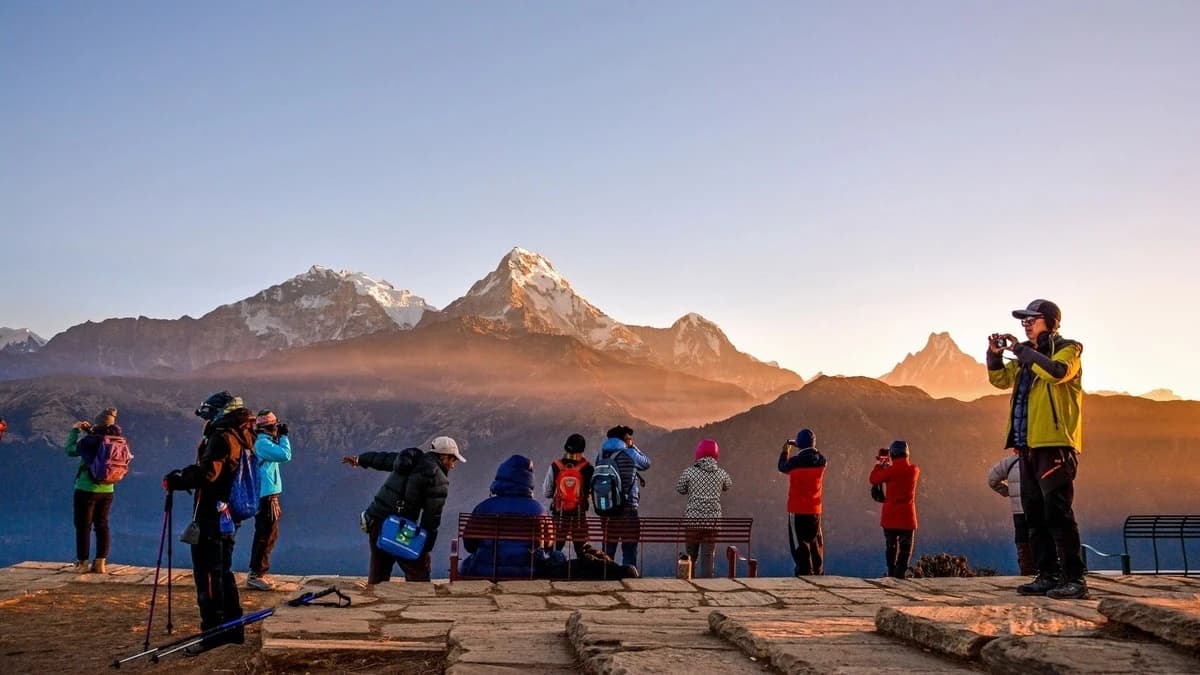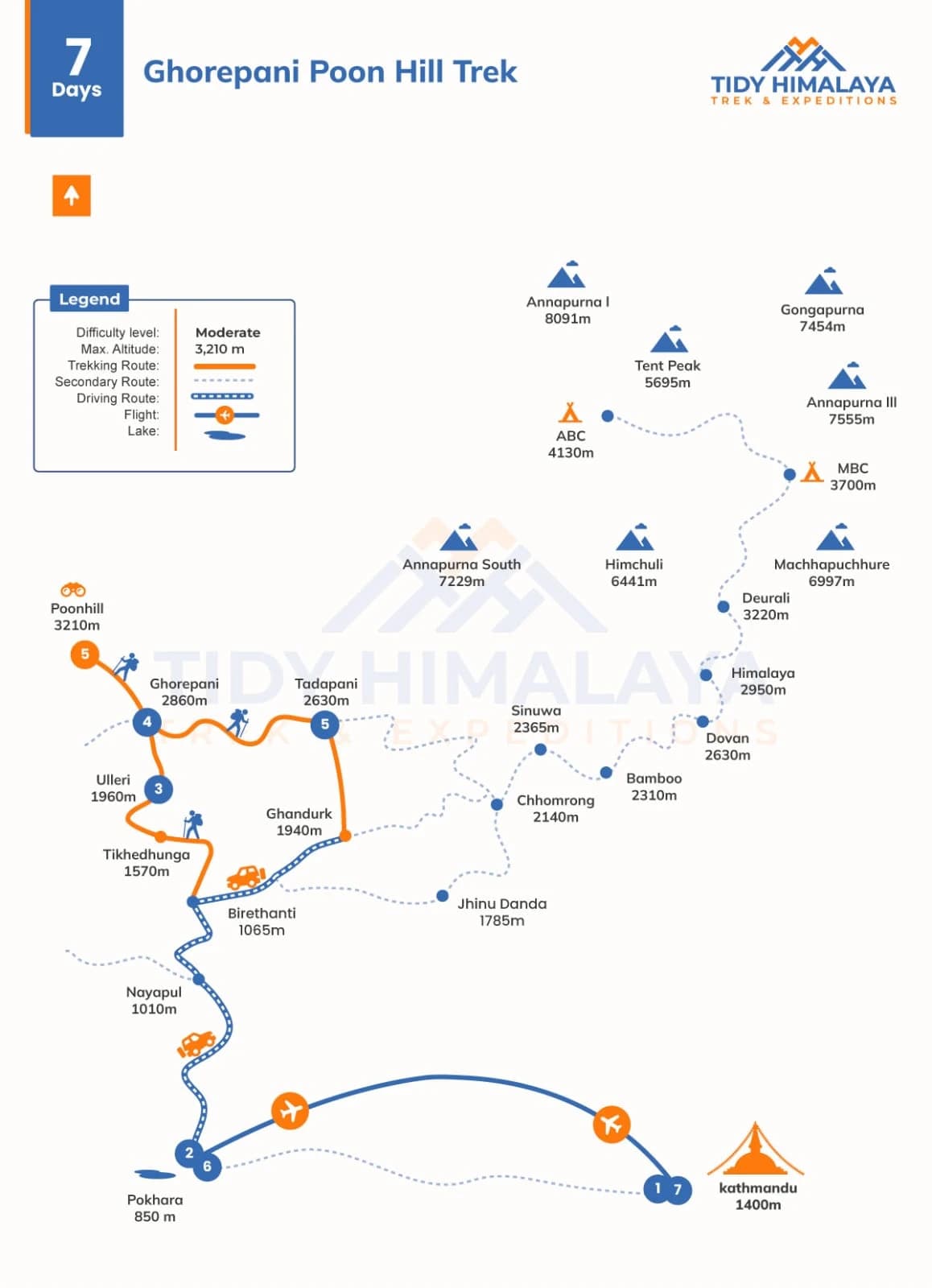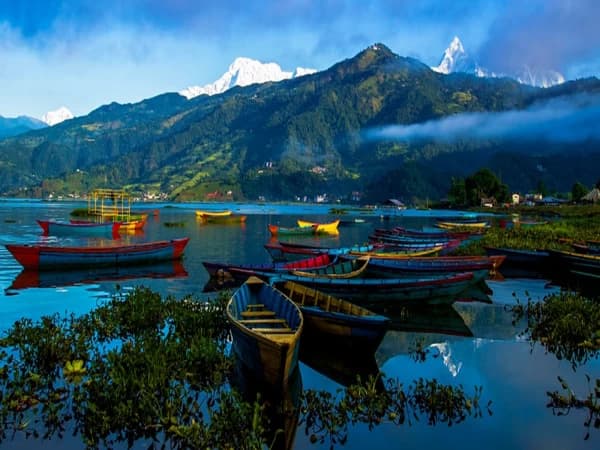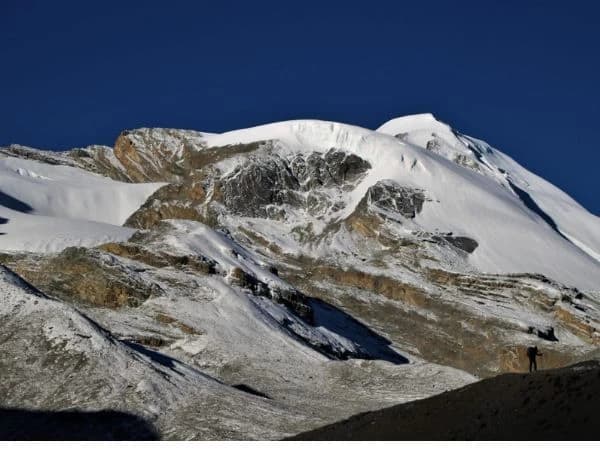Ghorepani Poon Hill Trek Overview
If you're looking for a Nepal trek that's short but very sweet, then your best option is the Ghorepani Poon Hill Trek. It's one of those treks that manages to fit in breathtaking mountain vistas, quaint villages, and rhododendron forests full of color into the span of a few days, without being too strenuous.
This trek is perfect for all ages and experience levels. Whether you’re a first-time trekker or a seasoned hiker, you’ll love the experience of walking through charming Gurung and Magar villages, crossing beautiful forests, and waking up early for a magical sunrise at Poon Hill (3,210m).
Speaking of Poon Hill, the view from the top is jaw-dropping. As the sun rises, it paints the sky with shades of orange and pink, lighting up the peaks of Dhaulagiri, Machhapuchhre (Fishtail), Annapurna South, Hiunchuli, and the Manaslu range. It’s a moment you’ll never forget.
The trek is also referred to as the Annapurna Sunrise Trek, and it's a great option if you don't have much time but wish to see the Himalayas.
Thus, if you are prepared for a stunning, simple, and short revitalizing trekking experience, Ghorepani Poon Hill Trek is calling!
Ghorepani Poon Hill Trek Outline Itinerary
Day 01: Arrive at Tribhuvan International Airport (KTM), Kathmandu (1,400 m/4,593 ft)
Day 02: Drive or fly from Kathmandu to Pokhara (850m) – Lakeside Exploration
Day 03: Pokhara to Nayapul drive – Trek to Ulleri (1,960m) (6-7 hours total)
Day 04: Trek from Ulleri to Ghorepani (2,860m) (4-5 hours)
Day 05: Poon Hill sunrise (3,210m) – Hike from Ghorepani to Tadapani (2,630m) (7 hours in total)
Day 06: Trek from Tadapani to Ghandruk (1,940m) – Drive to Pokhara (5-6 hours in total)
Day 07: Drive or Fly from Pokhara to Kathmandu
Day 08: Departure
Highlights of Ghorepani Poon Hill Trek
Sunrise from Poon Hill (3,210m/10,531ft) is the main and unforgettable highlight of Ghorepani Poonhill trek. It is a sight never to be forgotten to watch the sun rise and paint the Himalayan ranges of Annapurna, Dhaulagiri, and Machhapuchhre (Fishtail) with a golden hue. Panoramic views of these giant peaks from a near distance are simply breathtaking.
1. Car Ride from Pokhara to Nayapul
Your adventure begins with a scenic car ride from Pokhara to Nayapul (1,070m), the starting point of your trek. The 1.5 to 2-hour drive takes you through picturesque countryside, passing lush green hills and a view of Mt. Machhapuchhre, terraced farmlands, and traditional villages. Along the way, you'll witness the stunning landscapes of the Annapurna region, with glimpses of the snow-capped peaks in the distance
2. Cultural Wealth and Traditional Villages
In between, you pass through Ghorepani, Ulleri, Tadapani, and Ghandruk—villages which are rich in culture and tradition. You taste the hospitality of the Gurung and Magar tribes, inviting you to feel the essence of their legend and tradition. It is a chance to live the Himalayan way of life.
3. Breathtaking Panoramas of the Annapurna Range
You'll have wonderful views of Annapurna South, Hiunchuli, and Dhaulagiri along your Poon Hill trek. These white monoliths rise high in the distance to offer a stunning view behind your trek.
4. Comfortable Teahouses and Lodges Along the Route
Throughout the Ghorepani trek, you’ll stay in welcoming teahouses and lodges. These offer not just a place to rest, but also a chance to connect with fellow trekkers and enjoy delicious local meals. It’s the perfect way to relax and recharge after a day of walking.
Suitable for Everyone and Every Fitness Level
Ghorepani Poon Hill Trek is suitable for trekkers of any age and physical condition. The trails are simple and well maintained, and therefore it is a simple and slow-paced trek for beginner and experienced hikers alike.
Attractions of Ghorepani Poon Hill Trek
- Panoramic sunrise over the Dhaulagiri & Annapurna ranges from Poon Hill
- Trek through a lovely rhododendron forest & charming Gurung villages
- Local culture & hospitality experience in Ghandruk & Ghorepani
- Panoramic views of Machhapuchhre (Fishtail), Hiunchuli & other peaks
- Gentle & well-maintained trails, hence a trek for all ages

.webp&w=3840&q=75&dpl=dpl_2PwU5ZDv8uoJ3KrzEVbz8N547HgX)
.webp&w=3840&q=75&dpl=dpl_2PwU5ZDv8uoJ3KrzEVbz8N547HgX)
.webp&w=1200&q=75&dpl=dpl_2PwU5ZDv8uoJ3KrzEVbz8N547HgX)
.webp&w=1200&q=75&dpl=dpl_2PwU5ZDv8uoJ3KrzEVbz8N547HgX)
.webp&w=1200&q=75&dpl=dpl_2PwU5ZDv8uoJ3KrzEVbz8N547HgX)
.webp&w=1200&q=75&dpl=dpl_2PwU5ZDv8uoJ3KrzEVbz8N547HgX)




-(1).webp&w=1200&q=75&dpl=dpl_2PwU5ZDv8uoJ3KrzEVbz8N547HgX)